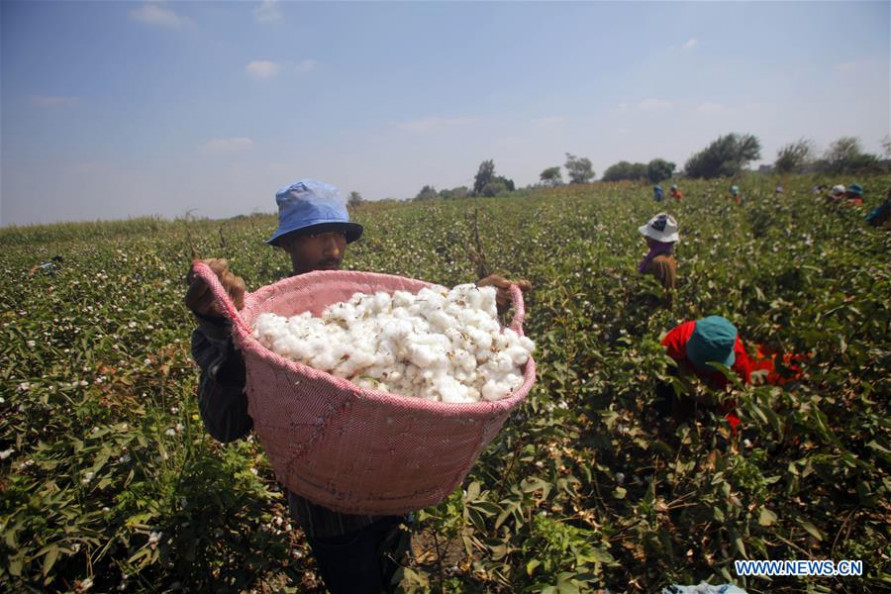By Mourad Kamel
There is no question on how important cotton is to Egypt’s textile industry: it contributes to around 3% of the country’s GDP, employs 2.25 million- one third of its industrial labour force - to meet its demand of 180 000 tons. But after years of trade wars between US and China, and now a global pandemic, the cotton industry in Egypt will need time to recover from its losses. In this fourth part of our series on the impact of COVID-19 on Egypt, we see how its prized 'white gold' will fare.
Egypt’s exports in cotton contributed $471.63m during 2019 to its GDP. But this ‘white gold’ for the country has taken a major hit, reducing production by 30% to 40%.
Even though Cairo has not imposed a full lockdown, as was seen in Nigeria or South Africa, its obligatory curfew and new health measures have affected cotton production and local demand. Egypt produces around 200,000 tons of cotton yearly and imports another 200,000 that it processes before exporting.
Cotton caught in the middle
The trade war launched in 2018 by US President Donald Trump, set tariffs and trade barriers on China against what was referred to as: “The greatest theft in the world”. Since then, cotton has taken a drop in prices plummeting from 15 to 20% globally. “When things started to stabilise in January 2020, nobody knew it was going to last for less than a month, [after] the pandemic hit” says Dr. Mohamed Negm, of the Cotton Research Institute and General Coordinator of the 13th Inter- Regional Network.
The WSJ reports cotton sold at $0.705 per pound of cotton on 29 January vs $0.6684 on 3 February; a drop of 23%. “The market, after COVID-19, collapsed. The three main cotton consumers – Europe, the US and Japan – were all under lockdown, which means nobody bought clothes” explains Negm.
Hit from the pandemic
The International Textile Manufacturers Federation did a survey on 700 companies, and orders for cotton were cancelled from March, April, and May. This means cancellations in 2020 could reach 31%, a total loss of $300bn for the global textile industry. “[The] summer is usually high for sales, but this summer will be different after COVID,” says Negm.
Egypt’s cotton industry was particularly hit hard by the pandemic given the government had just invested $1.25bn to modernize spinning, weaving, knitting, dyeing, finishing, printing and cut-and-sew manufacturing of the textile industry of the public sector. “The first machinery was supposed to arrive in April 2020, as well as foreign staff who would help us install it and train Egyptian employees by October 2020, but the pandemic halted everything. We will not be able to develop our production without a complete renewal of the whole supply chain” says Negm.
Uncertainty from the pandemic has left both farmers and consumers caught between a rock and a hard place.
After phase one of the partial agreement between the US and China, cotton growers around the world were hopeful that prices would reach previous heights. But with COVID-19, both farmers and consumers worldwide are now highly cautious: farmers are reducing cotton crops and are focusing on other products while popular retailers like Zara and H&M shut many of its stores worldwide from the fallout out of the pandemic, limiting consumers’ spending.
Not knowing how long the pandemic will last is another element creating anxiety for the industry. If the crisis keeps a minimal supply of cotton-based products for consumers, then farmers ultimately worry that the demand for cotton will continue to fall in parallel. “The timing couldn’t be worse, as the season to plant cotton begins in March and lasts until April” explains Mohamed Negm.
Visionary Egyptian farmers
Egyptian farmers also got hit with a 35% decrease in the amount of acres allotted for cotton plantation. So according to Negm, many farmers realised early on that they couldn’t ‘count on cotton this year, so they opted to prioritise food security.
Knowing that Egypt is a major foot importer, cotton farmers have begun planting their fields with more food crops. The health crisis has also had a negative impact on the local currency the Egyptian pound, which – like other currencies worldwide- has inflated. That means production costs for farmers have risen.
“It is also a question of survival for these farmers…Some farmers did not have time to choose different crops but many of them looked ahead,” based on what was happening elsewhere. If the pandemic had hit in November or December, planting season for wheat, farmers would have faced the same issue.
But changing crops is not always easy. “Not all farmers in Egypt and worldwide have the time to change plans. The machinery used in planting and processing cotton is different than the ones used in different crops”. Moreover, if the Coronavirus comes back [in a second wave], all crops will be endangered.”
Bottom line: Egypt’s longtime cash-crop has been hit with a double punch in 2020: caught in a trade war and the economic fallout of the global pandemic. While countries worldwide are starting to ease lockdowns and encourage consumer spending to reboost economies, for this year, it may be too late for Egyptian cotton.
Πηγή: theafricareport.com

